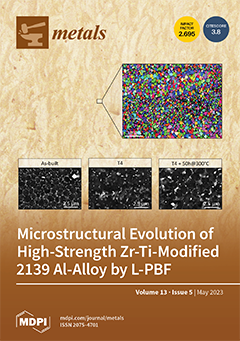This experimental study presents the machinability comparison of TiCN-Al
2O
3-TiN, TiAlN-TiN, and TiAlSiN coated carbide inserts in hard turning AISI 4340 steel. The primary purpose of this research is to determine the most appropriate cutting inserts in turning hardened AISI
[...] Read more.
This experimental study presents the machinability comparison of TiCN-Al
2O
3-TiN, TiAlN-TiN, and TiAlSiN coated carbide inserts in hard turning AISI 4340 steel. The primary purpose of this research is to determine the most appropriate cutting inserts in turning hardened AISI 4340 (30–40 HRC) steel considering surface roughness (Ra), cutting sound (Cs), power consumption (P), radial force (Fx), tangential force (Fy), and feed force (Fz). To fulfill this objective, the turning experiments for each tool were executed based on the Taguchi L
9 design. The comparative assessment of cutting tools revealed that the TiAlSiN coated tool exhibited superior performance compared to other tools. Machining with the TiCN-Al
2O
3-TiN coated tool showed 32.05% greater roughness than with the TiAlN-TiN coated tool, and 68.80% higher surface roughness than the TiAlSiN coated tool. The main novelty of this research is considering the cutting sound and power consumption as responses to select the most suitable cutting tools. Moreover, a novel grey-crow search hybrid was executed to perceive the optimal value of the input parameters. The optimal local value of cutting speed for the TiAlSiN coated tool was found to be 220 m/min, while for the TiCN-Al
2O
3-TiN and TiAlN-TiN tools, it was the same as 182 m/min. Considering the optimum cutting parameters, the material removal rate for TiCN-Al
2O
3-TiN, TiAlN-TiN, and TiAlSiN was found to be 639.9 mm
3/min, 606.4 mm
3/min, and 761.2 mm
3/min, respectively. Thus, the TiAlSiN coated tool has greater MRR capability in comparison to other tools. Therefore, this leads to the conclusion that the TiAlSiN tool may be the better choice in comparison to other selected tools for turning hardened steels.
Full article





